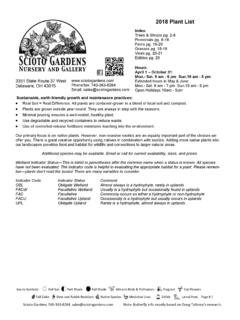Transcription of Frost Damaged Plants - Integrity Tree Service
1 Frost Damaged PlantsJohn Eisenhower, ISA Certified Arborist WE-5213 AIntegrity Tree Service , Inc. 602-788-0005 got frosted! January 2007 saw some of the coldest temperatures inPhoenix in twenty years. Whenever we get temperatures in the low to mid-twenties it can really devastate our landscapes. Many Frost -sensitive trees andshrubs can survive freezing temperatures for a night or two, but lowertemperatures are deadly for many non-native and even desert-adapted flora. Someareas of Phoenix got down into the teens! That s a recipe for widespread frostdamage in the Valley of the Sun. Unfortunately, Frost covers or Christmas lightsdon t help much when temperatures drop that low.
2 Well, what do you do now with your Plants ? Here are some tips. First, youshould wait until after February 15th to trim back dead leaves and branches. Thisis the average last day of Frost each year in the Phoenix area. If you prune beforethe 15th, there is a risk of another Frost and worse damage to your Plants . The deadleaves after a Frost provide some insulation against more cold of insulation, consider foliage as a plant s winter coat. For this reason,never trim Frost -sensitive plant varieties in late fall or winter. And after a Frost ,leave the dead foliage on until after February 15th. Barring a forecast for more cold weather, you can begin Springpruning at this time.
3 Some small shrubs and ground cover can be radically prunedback to stubs. You can also try to cut them back selectively, retaining as manylive branches as possible, but if they can stand to be cut back further, they willoften re-grow more uniformly and the pruning is simpler and faster. How youtrim them depends on the type of plant and the extent of damage. Some Plants cansustain heavy pruning. Others are more sensitive. Consult your local arborist ornursery for guidance on Plants that can sustain radical pruning. How to check on the extent of damage: With trees it is even more important toknow how far you can trim them back. To determine the extent of damage, youcan do two things: Investigate on your own after February 15th or wait until yourtree re-foliates.
4 If you don t want to or can t wait because you need yourlandscape back to normal sooner, this is an easy way to find out how far thefreeze affected your Plants : Starting at the smallest dead branch tips, use yourthumbnail or a small knife to scratch the bark to determine the color of theunderlying tissue. If the cambium below the bark remains green, the tissue isalive; if brown or black, it likely is dead. Continue on to larger twigs, stems andbranches until you find green cambium. When you find the green tissue, you cansafely remove the Damaged foliage outside that area. Some tree and shrubbranches are hard to tell. If in doubt, consider them alive. You can always prunethem out later.
5 Remember to check branches on all sides of the plant. Some canbe more Damaged than others in protected areas. A second method: The other option for determining the extent of damage to yourplant is to wait until bud break. For some Plants this may be right aroundFebruary 15th. For other Plants it may be several weeks later. At bud break, treesand shrubs re-foliate and let you know exactly how deeply they were branches that are dead will not re-foliate and you can simply cut back justabove where new growth emerges. On some trees you may be surprised that justleaves and small stems were Damaged . If this is the case, those leaves will dry outand drop, the tree will re-foliate and you may not need to trim at all.
6 Other timesthere may be slightly more damage and longer dead leafless branch tips. Youneed to decide whether to cut them or leave them. If you can stand to live withdead branch tips for a year or more, new growth can eventually grow past thedead ends. This usually is best for larger trees that are difficult to reach and withless than 12 inches of dead tips. If your damage is deeper than a foot into thetree s interior, it may be best to go ahead and prune the dead branches. Also, youshould prune them if you don t want to look at dead branches all heading cuts: Be sure, when pruning out dead branch tips, to avoidheading cuts if possible. Heading cuts result in a flush of new disorganizedgrowth from the ends of each cut branch.
7 This is another reason not to prunelightly Damaged branch tips unless you have to. Alternatively, hire a trainedarborist who can make proper pruning cuts. Avoid shearing. Look out for sunscald: Although trimming out dead branches dramatically helpsimprove the appearance of Frost - Damaged trees and shrubs, remember that yourplants will now be more exposed to sun without the normal protection providedby their foliage, even dead foliage. The shade provided by dead branches andleaves may give needed protection to your Plants while new foliage getsestablished. Especially keep this is mind with sun-sensitive Plants like it would be best to live with the deadwood until the re-growth is remove it incrementally as new foliage grows up and into the deadbranches.
8 The aim is to protect the sensitive bark and other interior parts of theplant as hot temperatures arrive. And you can provide that protection by livebranches or dead. Plants with south or west exposures are most vulnerable helpful remedies: While your trees and shrubs are recovering, you canencourage healthy re-growth by irrigating carefully. A Spring fertilizerapplication with nitrogen would also be helpful, never more so than now whenlush and vigorous re-foliation is so needed. If you have any further thoughts or questions, give us a call. We re here to helpget your trees back in shape as soon as possible! Integrity Tree Service , Inc. 2009
